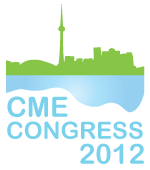Mohammad Alkhazim (College of Applied Medical Sciences, King Saud bin Abdulaziz University for Health Science); Alaa Thubaiti (College of Medicine, King Saud bin Abdulaziz University for Health Sciences); Taha Ismaeil (College of Applied Medical Sciences, King Saud bin Abdulaziz University for Health Science); Manal Alnasser (Post graduate Centre, King Saud bin Abdulaziz University for Health Sciences)
Continuous Medical Education (CME) is growing fast in Saudi Arabia; during 2010, the Saudi Commission for Health Specialties approved 41548 hours that spreads over 5511 activities of CME activities. However, new innovation in CME such as electronic learning is not adapted wildly in Saudi.
Purpose
The purpose of this study is to explore the perception of attendees of CME in Saudi Arabia regarding E-CME. Emphasis on factors that support or hinder E-CME.
Methods
A survey composed of demographic questions and related item instruments were developed for the participants of CME. Those participants were asked to indicate the extents to which they agreed or disagreed with each of the item on a 5-point Likert scale with endpoints that were labeled strongly disagree and strongly agree. 601 surveys were analyzed using the Statistical Package for the Social Sciences (SPSS) version 16 for Windows. The responses of each item in the questionnaire were compared on the basis of demographic variables including gender, professional titles, academic background and citizenship using Mann-Whitney’s U test and Wilcoxon’s signed ranks. A P-value <0.05 was considered significant. See attached table
| Frequency (%) of disagreement, neutral and agreement levels on electronic CME across the sample.. |
|||
| Electronic CME is | Disagree | Neutral | Agree |
| 12.1 An international trend | 33 (6.1%) | 144 (26.9%) | 359 (67.0%) |
| 12.2 Expensive | 121 (21.9%) | 196 (35.4%) | 236 (42.7%) |
| 12.3 Easy to access | 58 (10.8%) | 96 (17.9%) | 381 (71.2%) |
| 12.4 Suits different scheduling / timing | 49 (9.1%) | 113 (20.9%) | 378 (70.0%) |
| 12.5 Gives access to international experts | 22 (4.2%) | 87 (16.5%) | 417 (79.3%) |
| 12.6 Not require a large load of logistic and administration work |
60 (11.2%) | 159 (29.6%) | 318 (59.2%) |
| 12.7 Easy to document and replay again | 42 (8.0%) | 126 (24.0%) | 358 (68.0%) |
| 12.8 Complicated to deliver (technically) | 180 (33.5%) | 193 (35.9%) | 165 (30.6%) |
| 12.9 A boring method of teaching / training | 233 (44.4%) | 156 (29.7%) | 136 (25.9%) |
| 12.10 Needs special experiences / training | 140 (26.0%) | 164 (30.5%) | 234 (43.5%) |
| 12.11 Complicated to develop | 204 (38.6%) | 186 (35.2%) | 138 (26.2%) |
| 12.12 Time consuming | 254 (46.7%) | 168 (30.9%) | 544 (22.4%) |
| 12.13 Recognized method of teaching | 64 (12.1%) | 176 (33.3%) | 288 (54.6%) |
| 12.14 Hard to be accredited | 155 (28.7%) | 188 (34.8%) | 197 (36.5%) |
| 12.15 Well recognized by higher administrations | 77 (15.1%) | 214 (42.0%) | 219 (42.9%) |
Conclusion
This is the first of its type study that explores E-CME practice extensively in Saudi Arabia. The study showed the promoting and hindering factors for adapting E-CME as perceived by attendees of CME activity.





